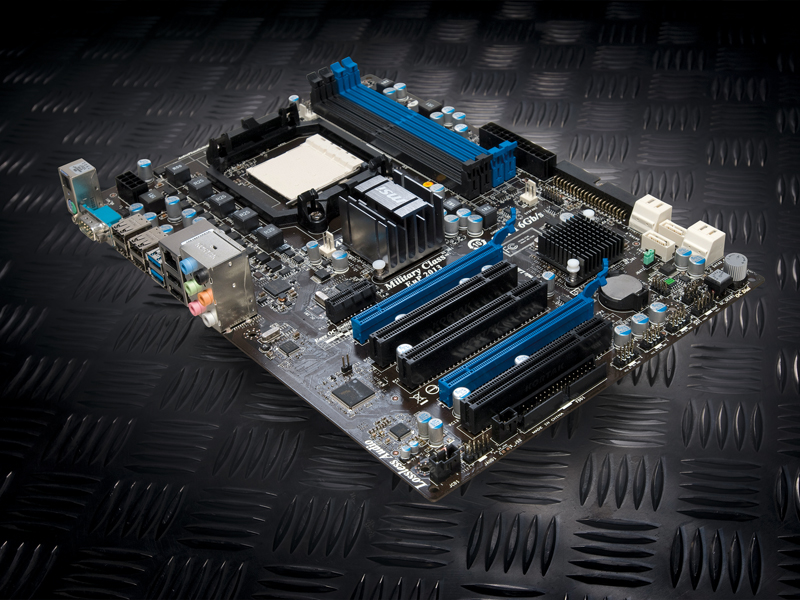TechRadar Verdict
Ticks all the boxes with SATA 6Gbps, USB on tap, plus plenty of overclocking headroom
Pros
- +
Great all round performance
- +
SATA 6Gbps and USB 3.0
- +
Tons of overclocking options
Cons
- -
Cheap looking chipset cooling
Why you can trust TechRadar
What's your take on integrated GPUs? When it comes to gaming, integrated graphics is obviously in no-touchy territory. But it gets the job done just fine for 2D or home cinema work.
Likewise, onboard graphics is a handy backup should your 3D card lose the will to render. However, if you're building a gaming or content creation rig on a tight budget, paying for the redundant circuitry doesn't make sense.
What you want is a no-nonsense motherboard that ditches the feeble integrated GPU and only gives you what you need. What you want is MSI's 870A-G54. Right? That's an affirmative, on paper at least.
MSI has plumped for AMD's entry-level 8 Series chip, the 870, but paired it with the top-spec SB850 southbridge. The result is a feature set that mostly nails it in terms of providing value for money from a discrete graphics motherboard.
Expansion slots include a pair of PCI-e x16 graphics ports, enabling multi-GPU CrossFireX gaming. Admittedly, you only get eight lanes per slot with both populated. But in our experience that's plenty for all but a pair of dual-GPU cards, such as the Radeon HD 5970.
Frankly, if you can afford two 5970 cards, you're hardly likely to be in the market for a budget AMD mobo like this.
The SB850 chip, of course, means SATA 6Gbps is on the menu. Similarly, MSI hasn't skimped on the USB connectivity. The ever-popular NEC USB 3.0 controller appears once again and enables two 500MB/s ports on the mobo's back panel.
Funky features
As if that wasn't enough, MSI has given the 870A-G54 some real overclocking chops. The OC Gear feature comprises both an on/off button and a toggle wheel. After hitting the OC Gear button on boot, the wheel can be twiddled back and forth to tweak the CPU bus speed.
By default, one click of the wheel bumps the bus speed by 1MHz. But you can choose any increment between 1MHz and 10MHz in the BIOS. It's a funky little feature, even if it doesn't work all that well in practice.
The problem is that all the relevant non-bus settings including memory dividers, voltages and the PCI Express to northbridge ratio stay constant. In other words, as fun as the OC Gear wheel is, you still get better overclocking results from hand-tuning the BIOS options.
That said, the board's alternative OC Genie tool works better than most auto-overclocking tools, cranking our Phenom II X4 955 up from 3.2GHz to 3.65GHz.
Just as impressive, for the most part, is the 870A-G54's application and storage performance. Only the ubermoney Asus Crosshair IV Formula beats it in the SSD throughput benchmarks, for instance. Likewise, it's near-as-dammit as quick as any board in the video encoding and professional rendering tests.
It's also not far off the ultimate pace for overclocking with a maximum bus frequency of 315MHz. That's actually more than we were expecting given the cheap-looking northbridge cooler and exposed MOSFETs.
The only real let down is the mildly disappointing 45fps in World of Conflict. Still, for just £79 it's a pretty compelling all round package.
Follow TechRadar Reviews on Twitter: http://twitter.com/techradarreview
Technology and cars. Increasingly the twain shall meet. Which is handy, because Jeremy (Twitter) is addicted to both. Long-time tech journalist, former editor of iCar magazine and incumbent car guru for T3 magazine, Jeremy reckons in-car technology is about to go thermonuclear. No, not exploding cars. That would be silly. And dangerous. But rather an explosive period of unprecedented innovation. Enjoy the ride.
